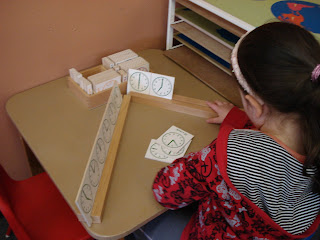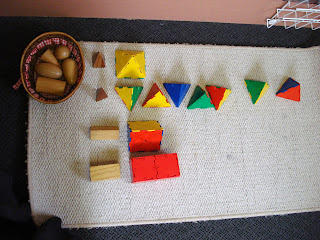 I've been meaning to do this post ever since I read this post at 'Our Montessori Story'. This is my attempt at explaining how to use the Bank game but its difficult to write it all down, a live presentation is the best!
I've been meaning to do this post ever since I read this post at 'Our Montessori Story'. This is my attempt at explaining how to use the Bank game but its difficult to write it all down, a live presentation is the best! The Bank Game [which is different from the golden beads bank game] is use for long multiplication. Before using this the children should have already had plenty of practice with the stamp game, dot exercise, small bead frame, large bead frame, checker board and flat bead frame. They should have also worked with all the multiplication boards and charts and already memorise some multiplication facts. So basically they should already have a good understanding of long and short multiplication.
This exercise should be done with a group of 3-4 children. There are four different roles that the children can play, the controller: who chooses the problem and makes sure the work is being done properly, the banker: who looks after the cards and hands them out, the cashier: who does the calculations, the book keeper: who does the recording.
The cards are laid out like this :
The white cards are used for getting the answers, the solid coloured cards are used to make the multiplicand and the grey cards are used to make the number that you are multiplying by.
For this presentation our problem will be 4621x13
The Cashier needs to ask the banker for 4621 which is broken down into 4000, 600, 20, 1 as below and placed in a stair. The cashier then asks the banker for 13 to multiply it with, this is 10 and 3 from the grey cards. These are placed on the right side of 4621.
 The cashier then starts the multiplication. He moves the grey 3 across to 4621 and starts by multiplying the stair from the top and asking the banker for the answer from the white cards. The white cards are placed in a horizontal line below the stair as in picture. So for this sum the child would do 1x3, 20x3, 600x3 and 4000x3.
The cashier then starts the multiplication. He moves the grey 3 across to 4621 and starts by multiplying the stair from the top and asking the banker for the answer from the white cards. The white cards are placed in a horizontal line below the stair as in picture. So for this sum the child would do 1x3, 20x3, 600x3 and 4000x3.

 The 3 card is then turned over and the cashier starts multiplying 4621 by 10 and placing the white answer cards in a horizontal line below the previous line. With the white answer cards all 10,000s 1000s, 100s and 10s are placed in columns under each other.
The 3 card is then turned over and the cashier starts multiplying 4621 by 10 and placing the white answer cards in a horizontal line below the previous line. With the white answer cards all 10,000s 1000s, 100s and 10s are placed in columns under each other.
 So the child will multiply 1x10, 20x10, 600x10 and 4000x10. Once the child has finished that he places the 10 upside down under the upside down 3.
So the child will multiply 1x10, 20x10, 600x10 and 4000x10. Once the child has finished that he places the 10 upside down under the upside down 3.
The white answer cards are then changed to simplify the cards, so 60 and 10 are changed for 70,..... 800 and 200 are changed for 1,000 and placed in the 1,000 column. Next 1,000, 2,000 1,000 and 6,000 are changed for 10,000 and that is placed in the 10,000 column. Finally the two 10,000 and 40,000 are changed for 60,000.
This then leaves us with 3 cards 60,000, 70 and 3. Which gives us the answer 60,073 as below.
I hope this helps anyone who is trying to figure out how to work with this, if you need any help leave a comment and I'd be happy to help if i can.














































